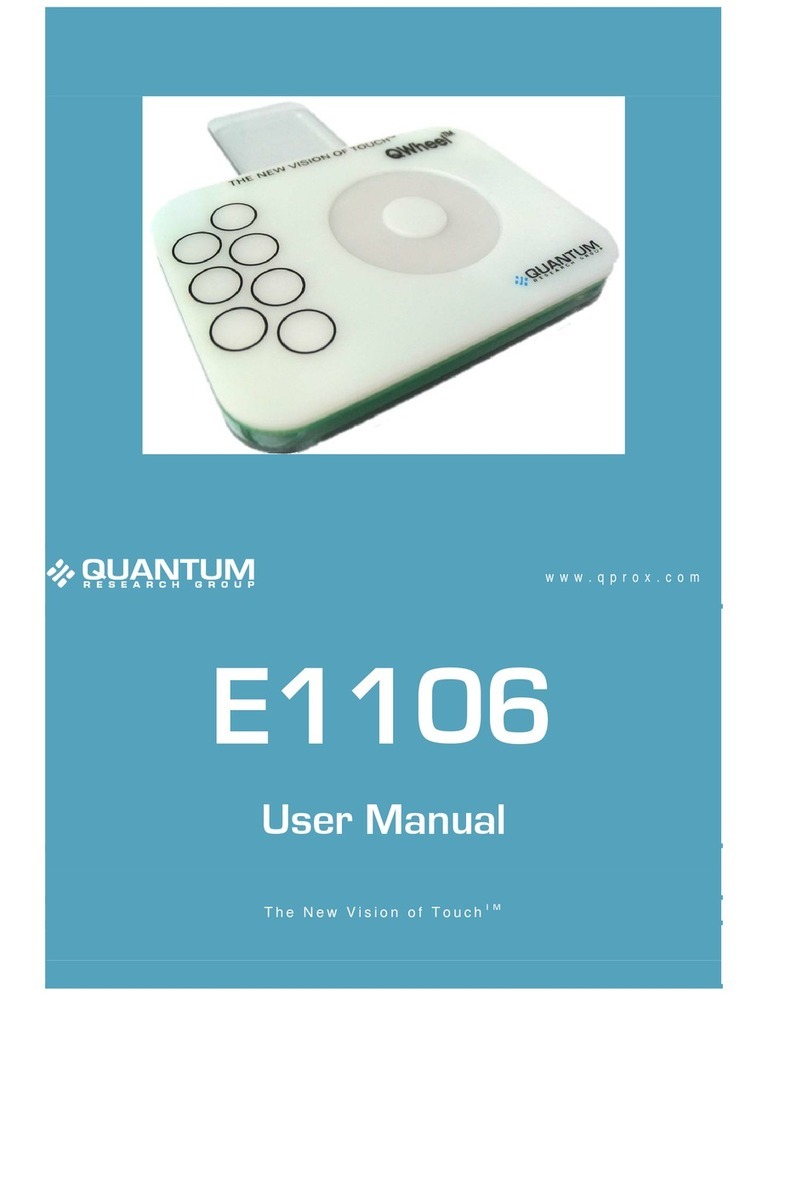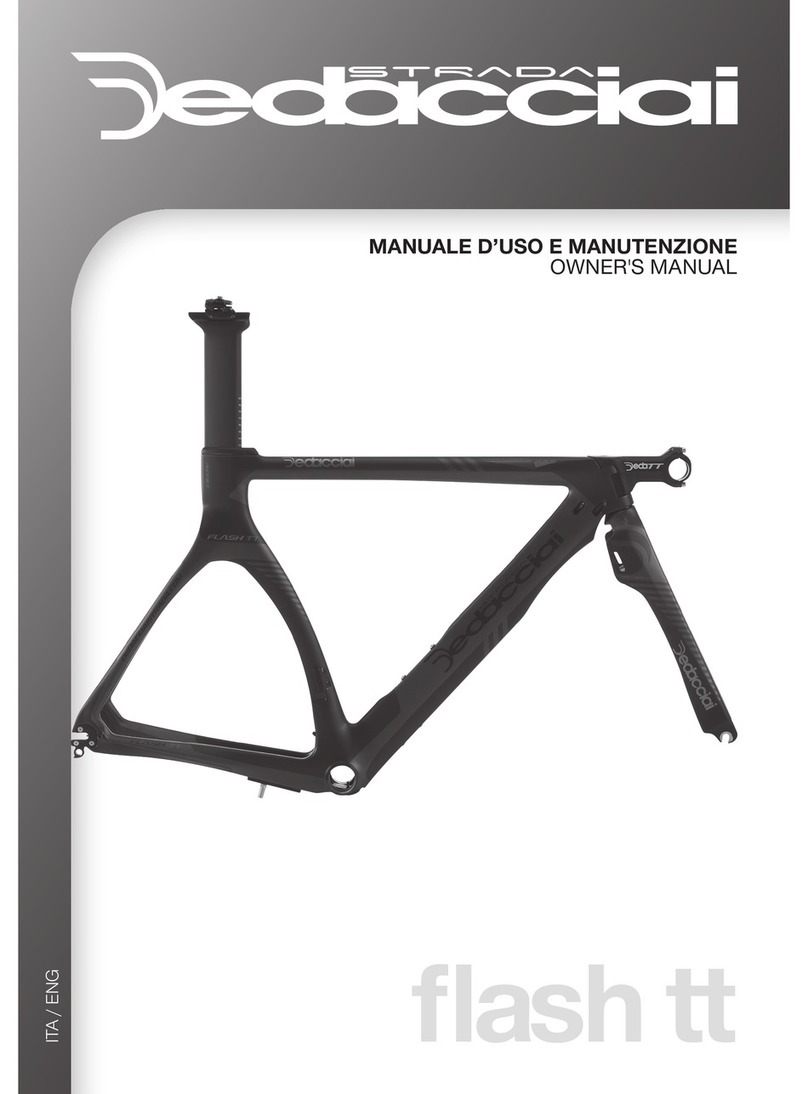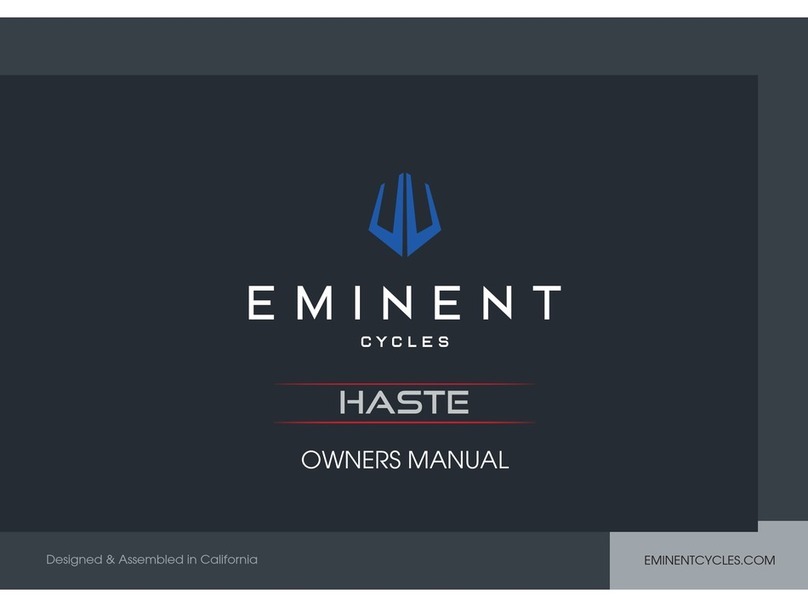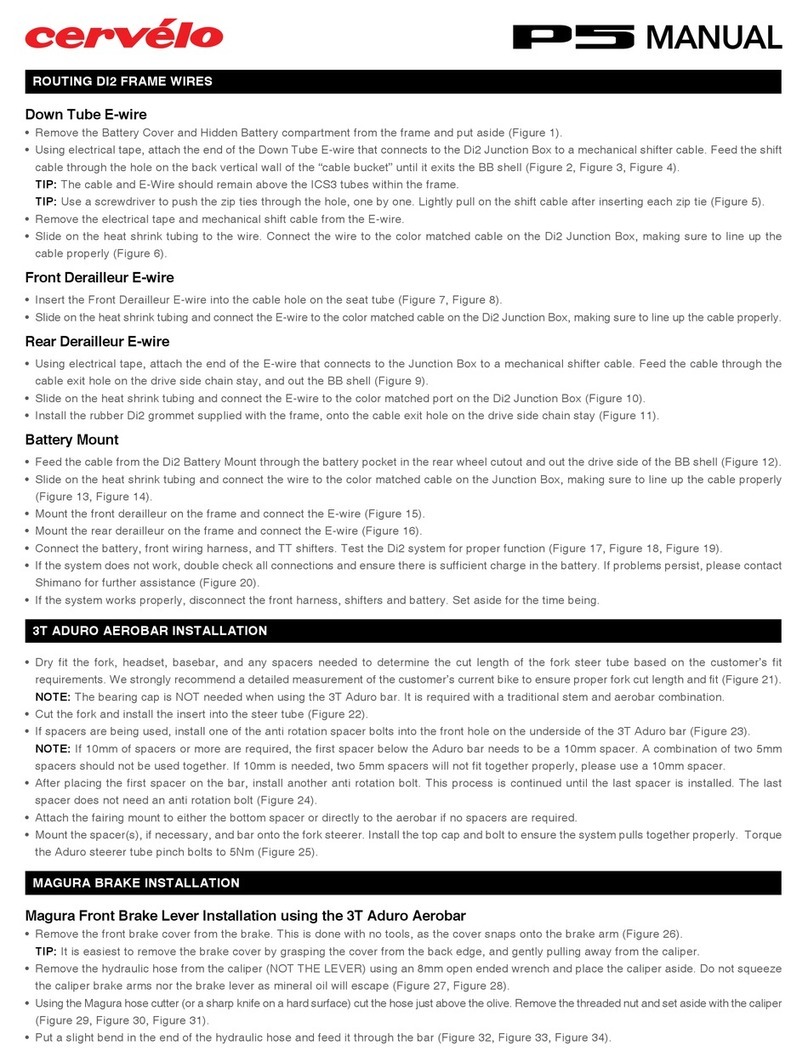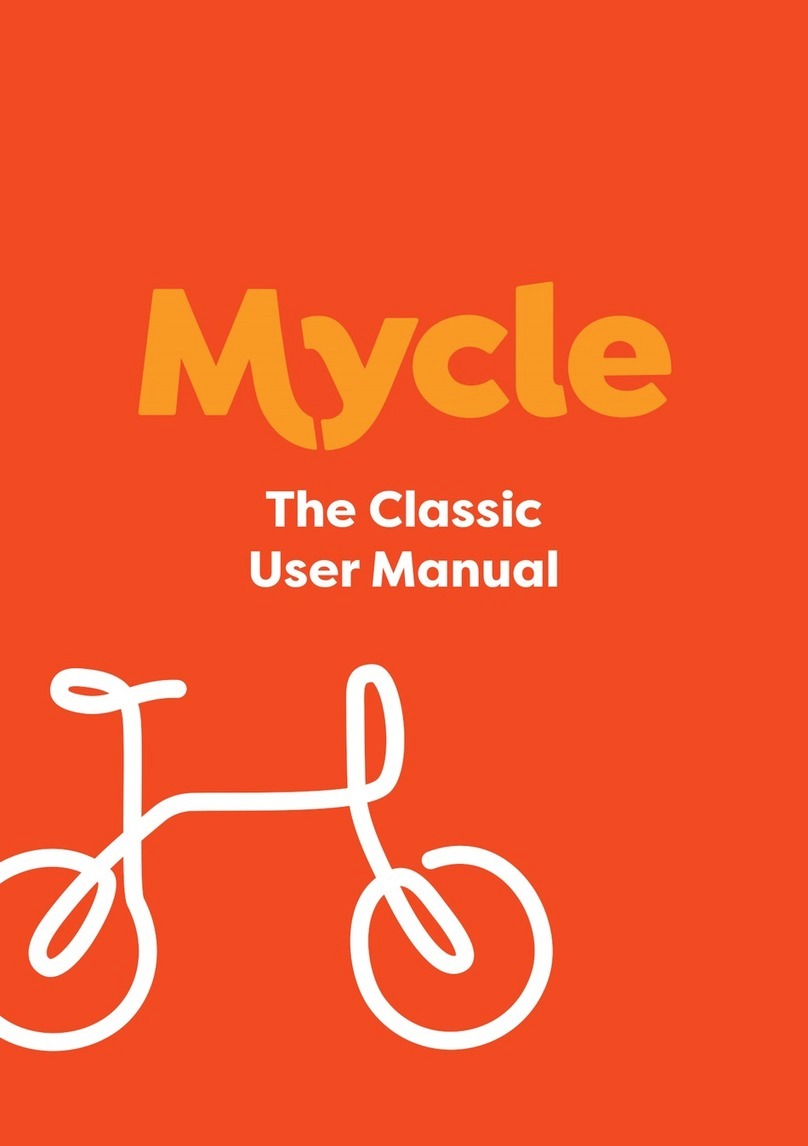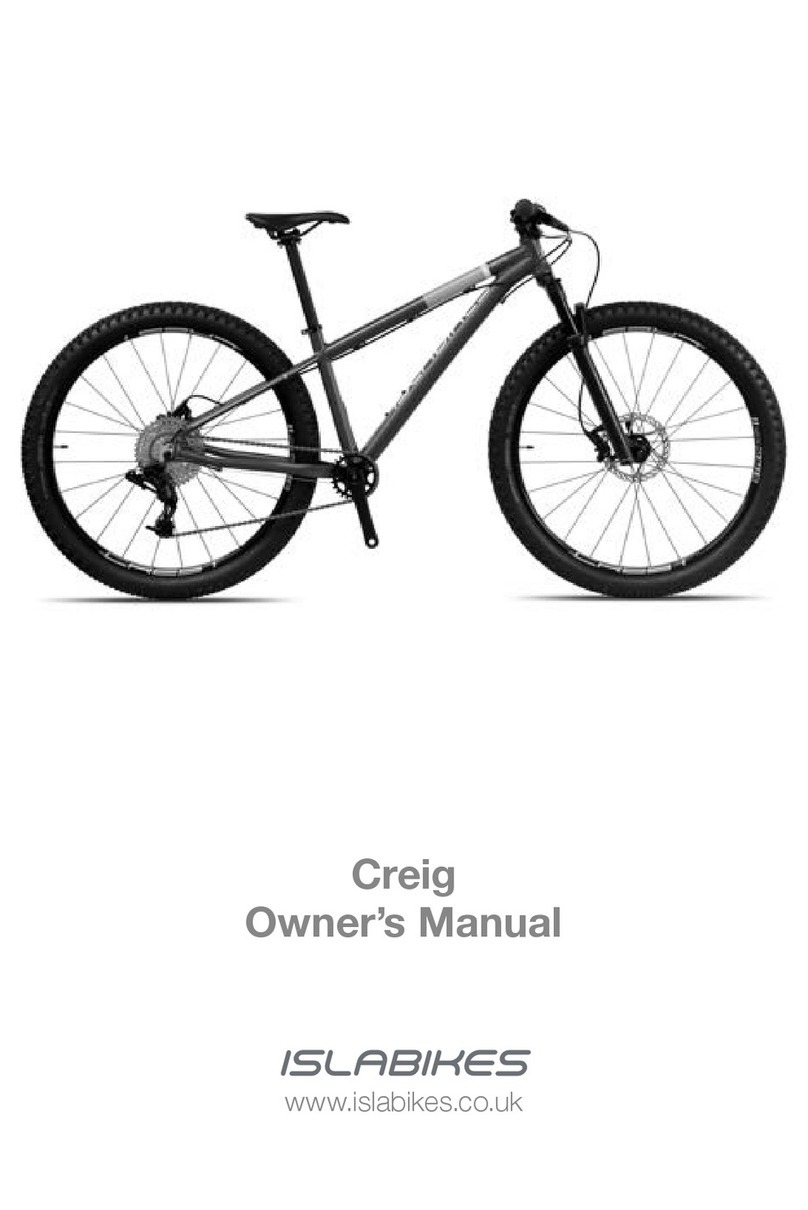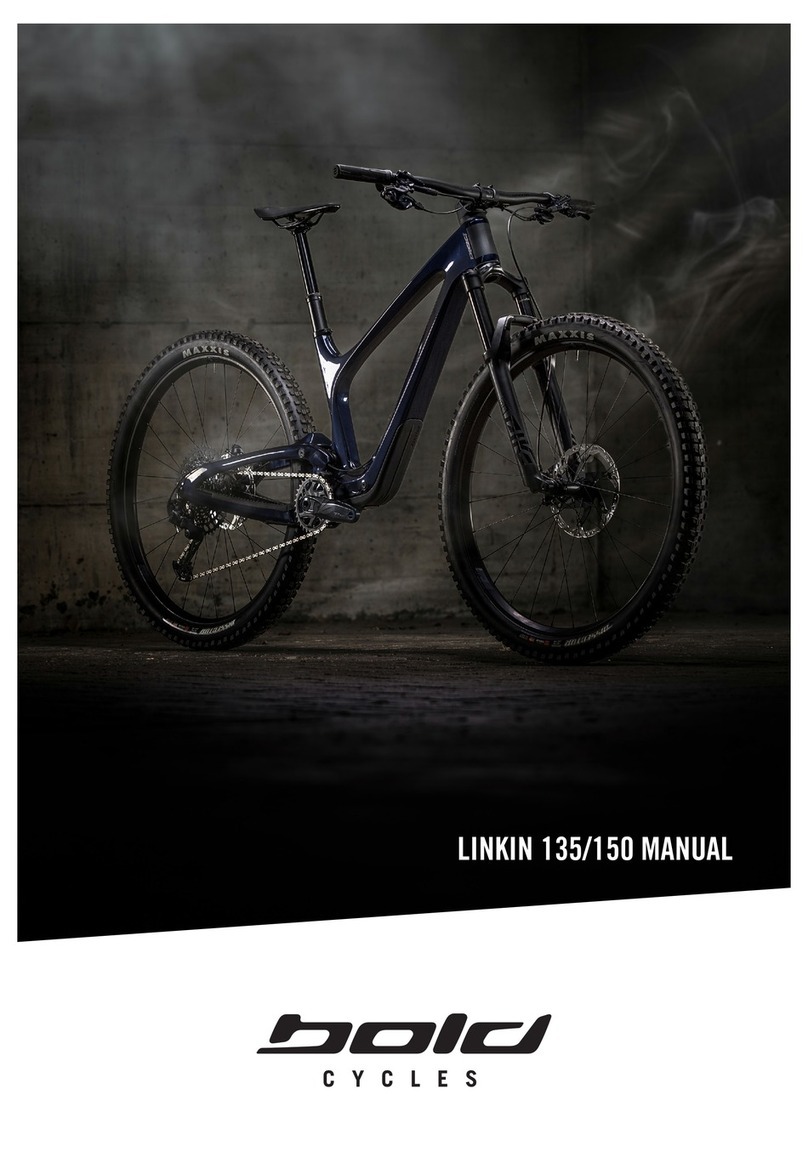Totem CS-240 User manual

CS-240/260
FOLDING ELECTRIC BICYCLE
OWNERS MANUAL

Manual Note: This manual applies to both the CS-240 and CS-260 Electric Bicycles.
GENERAL WARNING:
Like any sport, bicycling involves risk of injury and damage. By choosing to ride an electric
bicycle, you assume the responsibility for that risk. This manual provides some general
guidelines for safe and responsible riding and proper use and maintenance of your new
bicycle. We recommend that you also seek additional information about general bicycle
safety as well as the local rules and regulations regarding the use of this product on public
roadways and trails. Failure to adhere to the guidelines for proper use and maintenance of
your electric bicycle could reduce the risk of injury and reduce the lifespan this product.
1. Always wear a helmet.
2. Obey all traffic signs and regulations.
3. Ride your e-bike near the right-hand edge of the road.
4. Never carry another person on your e-bike.
5. Never wear headphones while riding as they impair your ability to hear traffic.
6. Always use hand signals when turning or stopping.
A special note for parents:
As a parent or guardian, you are responsible for the activities and safety of your minor child,
and that includes making sure that the electric bicycle is properly fitted to the child; that it is
in good repair and safe operating condition; that you and your child have learned and
understand the safe operation of the electric bicycle; and that you and your child have
learned, understand and obey not only the applicable local motor vehicle, bicycle and traffic
laws, but also the common sense rules of safe and responsible bicycling. Please read this
entire manual, as well as review its warnings and operating procedures with your child
before letting them ride the electric bicycle.
Finally, your child must always wear an approved bicycle helmet. Failure to follow this
warning could result in serious injury or death.
TOTEMUSA CS-240/260
2

Setting Up Your New Commuter Series Bike
You have received your new bike and are ready to test it out! The good news is the
CS-260 ships ready to go, but there are few safety checks that must be made prior to
taking it out for your test ride.
This section covers:
● Unboxing and Setting Up Your New CS model bike
● Sizing Guidelines for Proper Seat and Handlebar Adjustments
● Safety Checks Before Riding
● Basic Operating Instructions
Contents of Shipment
Your box should contain all the following items:
A. CS-240/260 Bicycle with folded handlebars
B. Battery Charger (two pieces – charger power block
and US power cord)
C. Keys – The keys are attached to the bike on either
the handlebars or the center folding lock latch.
Note - The keys are not for starting the bike but for
securing and removing the battery (anti-theft).
NOTE - If any of these components are missing or damaged, please
DO NOT RETURN. Contact TotemUSA using any of the methods
listed at the back of this manual and we will immediately address the
problem.
TOTEMUSA CS-240/260
3

Bike Assembly
The CS-260 ships fully assembled and ready to ride, with the exception of the pedals. The
CS-240 ships with the pedals installed. There are just a few simple steps to unboxing, pedal
installation, and some minor adjustments needed before you are on your way!
Step 1 – Remove All Packing Material
The Commuter Series bikes are packaged with tie wraps, rubber bands, foam inserts and
plastic gaskets to protect it in shipping. Carefully remove all this material and discard. Note
– the battery keys are attached to the center folding lock hinge OR the handlebars with a tie
wrap. Once complete, the bike will look like the image below:
Step 2 – CS-260 Pedal Installation
(Note - the CS-240 ships with the pedals installed) To install the pedals you will need a
15mm (or small adjustable) wrench. The pedals thread into the pedal crank holes. Note -
The right-side pedal threads into the hole in the clockwise direction, while the left side pedal
threads into the hole in the counterclockwise direction. Ensure that the pedals are threaded
in as far as possible and tight.
The pedals fold up for storage and transport. You will see a small oval-shaped hole on the
CS-260 with an arrow that when pulled allows the pedal to swing into the folded position.
TOTEMUSA CS-240/260
4

TOTEMUSA CS-240/260
5

Step 3 – Raise Handlebar and Lock Into Position
Grab the handlebars, making sure they are free from the pedals, and pull them up into the
locking position. Secure the handlebars by pressing the lock level into place. The bars are
not locked until the knob on the right side of the level clicks into place. To unlock the
handlebars, press the knob on the right side of the lever down then pull on the lever to
release the lock and allow you to fold up the bar. See section 1.3 for recommendations for
proper handlebar height settings.
Step 4 – Adjust the Height and
Rotation of the Handlebars
Make sure the latch on the top of
the handlebars is open. Grab the
grip and rotate the bar so that the
reflector is facing forward and the
brake levers are in a comfortable
position. Close the latch on top
of the bar. If the latch is too difficult to close, slightly adjust the tension knob located
underneath the latch. Make sure that the latch closes very tightly so that the bar cannot
rotate. If the bar can be moved, open the latch, tighten the tension knob slightly, reclose
the latch and test again. Once the bar is secured, the height of the bar can be adjusted
using the latch located between the bar and the frame. See the next section for
recommendations for proper handlebar height settings.
Step 5 – Adjusting the Seat
Locate the latch under the seat and open. Slide the seat up to the desired height. Confirm
the seat is aligned properly with the frame then secure it in place by closing the latch. If the
pole is not securely locked in place with the latch, open the latch and adjust the tension
knob until the seat is completely immobile with the latch closed. See the next section for
recommendations for proper seat height settings.
TOTEMUSA CS-240/260
6

Recommended Height Settings for Seat and Handlebars
NOTE: The correct fit is an essential element of bicycling safety, performance, and comfort.
Making the adjustments to your electric bicycle which result in correct fit for your body and
riding conditions requires experience, skill and special tools.
Stand over height
Stand over height is the basic element of electric bike fit. It is the distance from the ground
to the top of the bicycle’s frame at the point where your crotch would be if you were
straddling the bike and standing half way between the saddle and the handlebars. To check
for the correct stand over height, straddle the bike while wearing the kind of shoes in which
you’ll be riding and bounce vigorously on your heels. If your crotch touches the frame, the
bike is too big for you and would not be safe for you to ride. Please contact TotemUSA to
return this bike for a full refund.
Saddle (Seat) Position
Correct saddle adjustment is vital to getting the most performance and comfort from your
bicycle. The saddle can be adjusted in two ways:
Vertical Adjustment - This adjustment is usually all that is required for most riders. To make
this adjustment, use the latch shown in Step 5 above.
To check for correct saddle height, follow the steps below:
• Sit on the saddle
• Place one heel on a pedal
• Rotate the crank until the pedal with your heel on it is in the lowest position
• Check the extension of your leg. If the saddle is in the correct position, your leg should be
slightly bent. If your leg is nearly straight, then the saddle should be lowered. If you
leg is bent more than 30 degrees, it should be raised. Between these two extremes,
you should ride it to find the comfortable position for your riding style.
WARNING: Check to make sure you have set the seat between the Minimum Insertion and
Maximum Extension marks! Extension of the post outside of this range will put you
at risk damaging the bike and injuring yourself.
Saddle Angle Adjustment - The saddle angle can also be tilted forward or backwards to
help you get the optimal position on the bike. This is not usually required, but can be
adjusted with a size 6 metric Allen (hex) key on the underside of the saddle.
WARNING: After any saddle adjustment, ensure that the saddle is properly and securely
tightened before riding. A loose saddle clamp or seat post binder can cause damage
to the seat post and loss of control while riding. A correctly tightened saddle will
have no movement in any direction.
Before riding, the tires MUST BE FULLY INFLATED to 60 PSI. Failure to do this could
result in damage to the tire and tube.
TOTEMUSA CS-240/260
7

Digital Display and Control Unit
The digital display is located on the left side of the handlebar.
When the power is off, you will see a blank screen.
To turn the bike’s battery on, locate the power switch on the front
left side of the frame. The circle indicates the “off” position and
the line represents the “on” position. Toggle the switch to “On.”
Once the switch is toggled to the “On” position, locate the power
button for the digital display on the top left corner of the display
module.
Display Items
When the display is turned on, you will see the home screen showing the current battery
charge, current speed, pedal assist level, and either the odometer or the current trip
distance.
The display automatically cycles between displaying the odometer or the current trip
distance every 5 seconds.
Activating the Backlight
To turn on the digital display backlighting, simply press
and hold the DOWN (-) button for 3 seconds and let go.
To turn the backlight off, press and hold the DOWN (-)
button for 3 seconds and let go.
Pedal Assist (PAS)
Press and release the UP and the DOWN button to change the PAS level. The available
settings are 0-5. Setting it to “0” disables the PAS and Throttle modes, putting the bike in
full manual (pedaling) mode. Modes 1-5 changes the amount of additional the thrust the
motor provides (1 being the lowest and 5 being the highest). These can be changed at any
time while riding.
TOTEMUSA CS-240/260
8

Auto (Throttle) Mode
Both CS models come equipped with a thumb paddle style
throttle located underneath the display on the handlebars.
This throttle control functions as an “on and off” function
rather than a variable increase in speed like traditional twist
style throttles found on motorcycles.
To engage the full assist mode using the throttle, simply begin moving the bike forward by
pedaling, then press the thumb paddle forward, and you can stop pedaling. The bike needs
to be moving forward before the full assist will engage; it will not take off on its own from a
stand-still. This feature was designed as a safety measure.
To disengage the full assist mode using the throttle, simply let go of the throttle and the
motor will disengage. You can also use the brakes to disengage the motor.
Note: the PAS level setting must be set on a value from 1-5. Setting it to 0 will disengage
auto mode.
TOTEMUSA CS-240/260
9

Understanding your Battery
Safety Lithium-ion batteries have a high energy content when charged. The contents of
these cells can be flammable in the right conditions. These batteries should always be
handled and stored carefully. Temperatures below 15° F and above 140° F should be
avoided. Avoid mechanical stresses such as dropping your battery on hard surfaces. Avoid
coming in contact with moisture; always remove the battery prior to washing your bike.
Note: The CS models are protected from normal wet riding conditions by a rubber gasket.
NEVER open the battery’s black plastic housing. Failure to do so will void any warranty,
implied or otherwise.
Charging The 36V lithium-ion battery included with your new bike ships partially charged.
Batteries should be charged in a dry location at room temperature. The best charging
practice is to fully discharge the battery, then fully charge it. The charger is equipped with
over-current protection for safety. The LED light on the charger is red during charging and
green when fully charged. Once the battery is fully charged it should be removed from the
charger. Never leave a battery connected to a charger for long period of time unattended.
Charging time depends on the battery capacity, but typically can be charged from zero to
100% in 6 hours.
Distance There are many variables that can affect the total range on a fully charged
battery. Environmental factors that affect distance are road surface type, terrain type
(including steep hills), frequent stopping and starting, temperature, and wind. Rider
variables including total weight and riding posture will affect the range. Bike factors such as
tire tread, gear shifting, and the level of selected pedal assist will all influence the total
range. On average, you can expect to travel 40 miles or more on a fully charged battery
using pedal assist.
Lifespan The "power loss curve" for lithium-ion batteries is a depiction of how the battery
loses its full potential over its lifetime. This is a gradual curve downward caused by many
variables such as charging habits, work load, temperature, and age. During the initial 500
charges a single charge may last 4 days or 40 miles. Over time, it may drop to 80% of the
original potential, then 70%, and so on until the battery must be charged too frequently to
use. Near the end of the usable life of the battery, a typical 6 hour charge may only result in
a 10 mile range. Lithium-ion batteries degrade over time, even if you don’t use them.
Storage & Transport Optimal storage locations are dry, well-ventilated areas with smoke
detectors. NEVER store your battery near heat sources or flammable materials. Avoid
storing the battery inside the bike in direct sunlight. For long periods of storage, the battery
should have a 50% charge. Prolonged storage in a fully charged or discharged state will
decrease the life of the battery. We recommend that the battery be removed from the bike
for transport.
Replacement Additional batteries and chargers for both the CS-240 and CS-260 are
available for purchase on our website at www.totemusa.com Batteries that can no longer
TOTEMUSA CS-240/260
10

be used should be properly disposed of at a recycling facility.
TOTEMUSA CS-240/260
11

CS-260 Basic Maintenance
Proper maintenance and cleaning of your Totem USA CS-260 will extend the life and
function of your bike. A well-maintained bike will keep you out on the road for many years to
come. An improperly maintained bike can lead to a whole host of issues both mechanically
and electrically. We strongly encourage our customers to follow the basic maintenance
procedures outlined below.
Useful tools:
● Metric Allen wrench (hex key) set
● Multi-tool
● Phillips and flathead screwdrivers
● Bike lubricant
● Bike chain degreaser
● Small brushes for cleaning
● Bike tire pump
The CS-260 ships fully assembled with the exception of the pedals. Although not required,
it is a good idea to fine tune the bike, either by yourself or with a bicycle mechanic, upon
arrival as things may have moved during shipping.
We recommend that the tires be inflated to 60 PSI before your first ride. It is very important
to maintain proper tire pressure for both safety and performance.
Bicycles tend to last longer when they are stored inside. When constantly exposed to the
elements, the life expectancy of the bicycle’s electrical system, chain, braking system, and
paint finish all greatly diminish. Similarly, bicycles ridden in wet and dirty conditions will
require more cleaning and service to properly maintain.
Before each ride: Check the tire pressure of both the front and rear tires. Look at the tread
on the tires for embedded debris to avoid getting a flat tire while riding. Check the
quick-release adjustment points on the handlebars and seat post to make sure they are
tight. Check both the front and rear brakes to make sure they are fully engaging. Visually
inspect the bicycle chain to make sure it is properly lubricated. Do not use products like
“WD-40” to lubricate your bike chain. These lubricants do not last in outdoor environments
and can actually remove the thicker grease needed for proper lubrication.
Monthly: Wipe the bike frame down with a cloth to remove and build-up of dirt and debris.
Visually inspect the bike for signs of wear including loose screws, or cracks or dents at
stress points. Using a brush, rag, and degreaser, wipe the dirty grease build-up from the
chain, chainring, and rear sprockets. Make sure to re-grease these parts after cleaning to
maintain proper lubrication. Check the spokes on the tires to make sure they aren’t loose.
Rotate each wheel off the ground to make sure it is rotating true and not wobbling. Lastly,
using wrenches and screwdrivers make sure that all the connection points are securely
tightened around the bike.
Annually: Check the bike for signs of corrosion and rust. Visually inspect the brake system
cables and brake pads or discs and replace as needed. Inspect the tire tread for signs of
uneven wear and dry-rotting, and replace as needed. Clean, degrease, and apply fresh
clean lubricant to the chain and sprockets. Using a wire brush, remove any signs or rust or
corrosion from metal parts. Check and re-grease the bearings in the pedal crank. Check all
TOTEMUSA CS-240/260
12

connection points and accessories for signs of wear.
Warranty Information
Please refer to our website at www.totemusa.com for current Warranty information.
Visit our website to get additional information:
www.totemusa.com
ANY ISSUES OR
FOR FURTHER ASSISTANCE
PLEASE EMAIL:
Or Call Us at
(812)807-1570
TOTEMUSA CS-240/260
13
This manual suits for next models
1
Table of contents
Popular Bicycle manuals by other brands

Evinci
Evinci TUI+ quick start guide
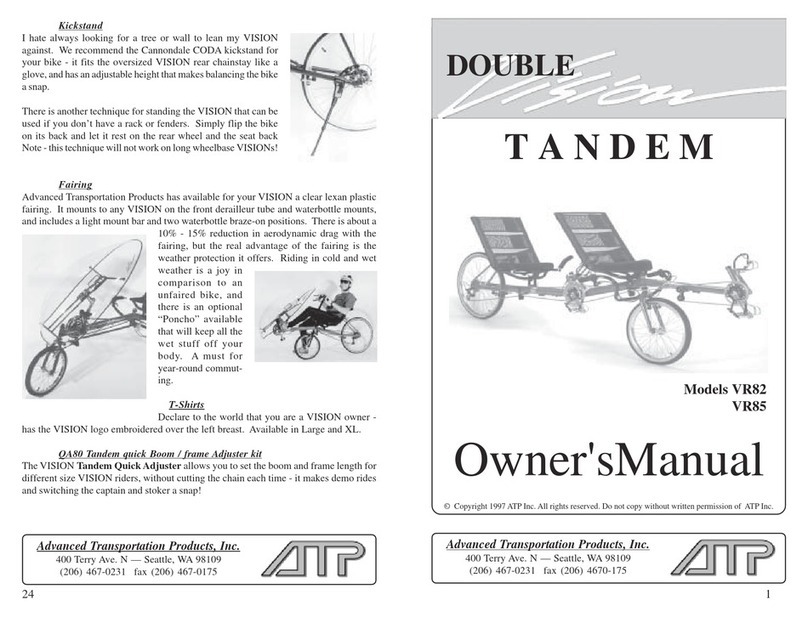
ATP Electronics
ATP Electronics VR82 Double Vision Tandem owner's manual
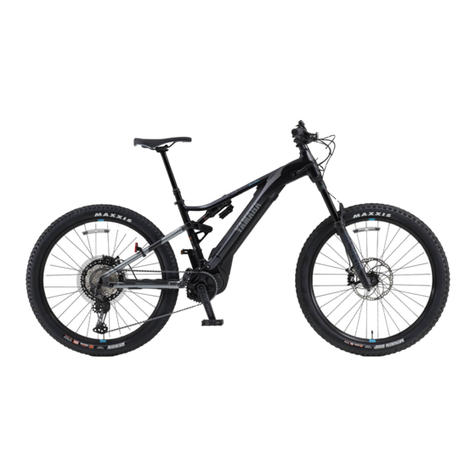
Yamaha
Yamaha YDX-MORO 07 Assembly manual
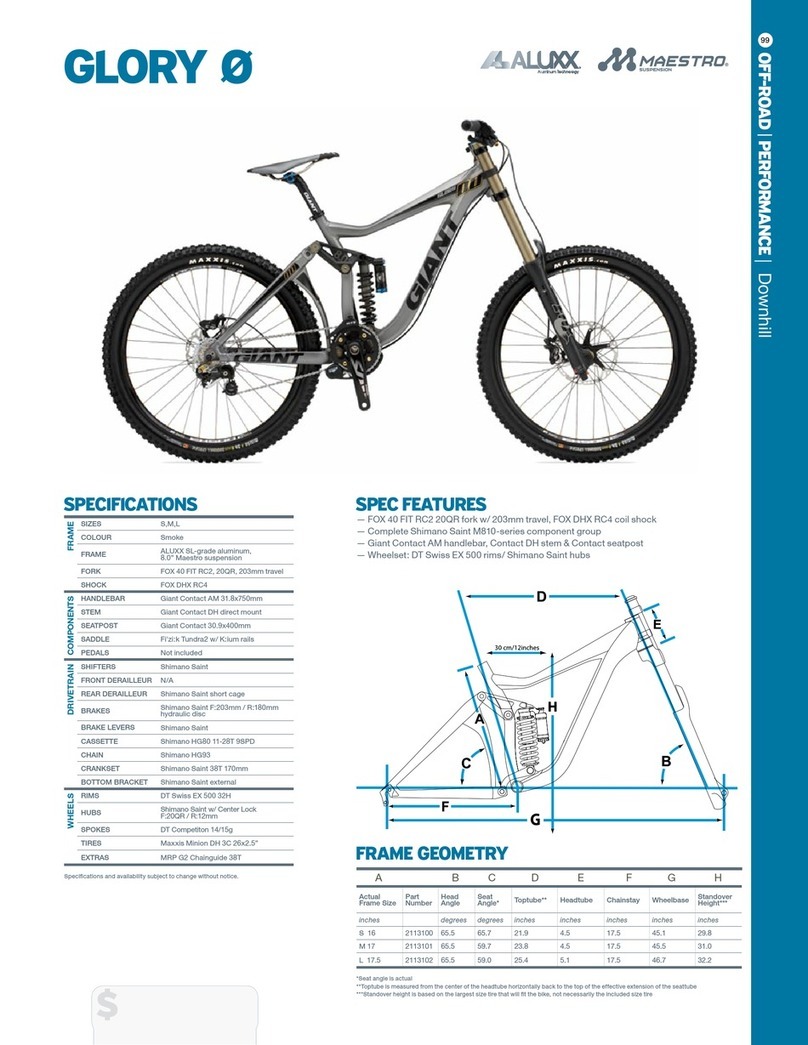
Giant
Giant GLORY 0 - DATASHEET 2 datasheet
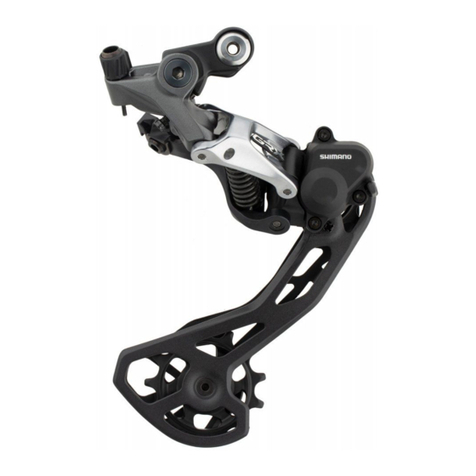
Shimano
Shimano GRX RD-RX810 Dealer's manual

Standard Bearer Machines
Standard Bearer Machines RUNGU Electric Juggernaut Mid-Drive owner's manual
